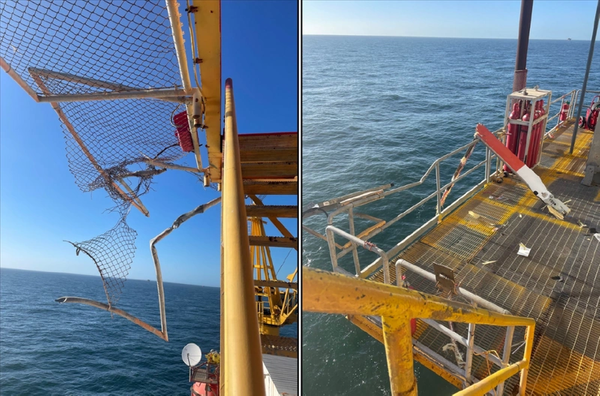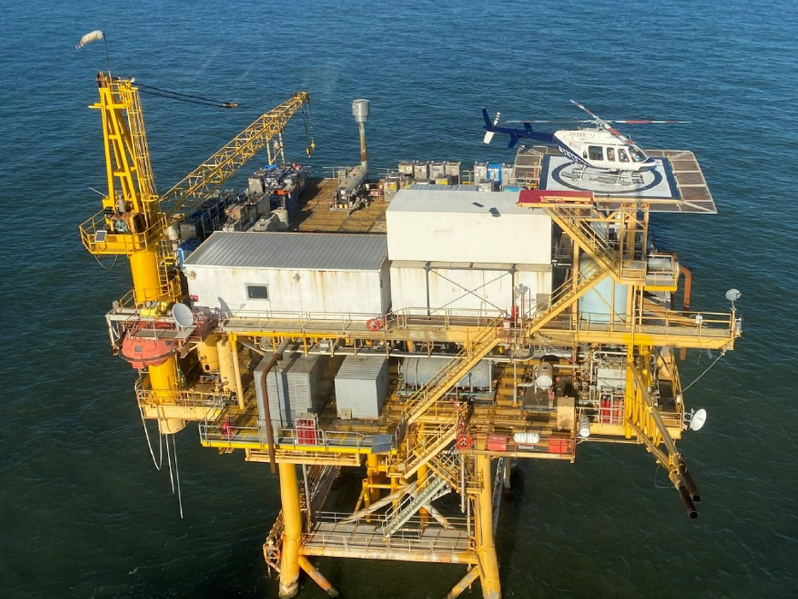
The U.S. National Transportation Safety Board has released a preliminary report on the December 29, 2022, fatal helicopter crash near a Gulf of Mexico oil platform. One pilot and three passengers died in the incident.
"On December 29, 2022, about 0834 central standard time, a Bell 407 helicopter, N595RL, was substantially damaged during takeoff from an offshore platform in the Gulf of Mexico. The pilot and 3 passengers were fatally injured. The helicopter was operated as a Title 14 Code of Federal Regulations Part 135 flight," NTSB said.
According to NTSB, on the morning of the accident, at about 0748, the helicopter departed the Rotorcraft Leasing Company LLC base located at South Lafourche Leonard Miller Jr. Airport (GAO), Galliano, Louisiana, for a visual flight rules (VFR) passenger flight to the West Delta 106 (WD106) offshore platform in the Gulf of Mexico. The direct flight path to WD106 was 51.6 nautical miles (nm) to the southeast of GAO.
Landing on the platform
NTSB said that, at about 0825, the helicopter landed WD106, and the pilot reportedly landed on a southeast heading.
Four passengers exited the helicopter and proceeded below the helipad where they had a short discussion with the platform workers that were scheduled to return to the mainland on the helicopter. Then, three platform workers boarded the helicopter before it departed.
According to NTSB, there were no eyewitnesses or surveillance video of the helicopter’s departure from the WD106 helipad; however, there were several individuals who reported hearing the helicopter operating while on the helipad.
These individuals noted that the helicopter’s engine continued to run after it landed on the helipad, and that they heard the engine noise increase for takeoff and then the sound of items hitting the platform, NTSB said in its report.
Upon hearing the sound of items hitting the platform, they immediately went outside and saw the helicopter fuselage floating inverted in the water with the tail boom separated but adjacent to the fuselage.
The landing skids were separated from the fuselage, and the emergency skid floats were inflated.
Rescue attempt
Several individuals on the platform then boarded and launched the platform’s emergency escape capsule, but the helicopter fuselage sunk before they could render assistance to the four occupants who remained inside the fuselage, NTSB said.
 Image 1 – Overview photo of West Delta 106 platform with exemplar Bell 407 helicopter on the
Image 1 – Overview photo of West Delta 106 platform with exemplar Bell 407 helicopter on the
helipad. The helicopter is facing southeast on the helipad. The damaged chain link perimeter
skirt on the southwest side of the helipad was removed after the accident.
The WD106 platform is equipped with a 24 ft by 24 ft helipad, as shown in Image 1 above.
The helipad was constructed of recently repainted metal and was surrounded with a chain link perimeter skirt. Eight lights outlined the perimeter of the landing pad.
The stairwell leading down from the helipad was recently painted red. The helipad was located on the southeast corner of the platform and about 100 ft above the water.
Examination of the helipad revealed the red paint of the stairwell was gouged and scratched near the southwest end, nearest the skirted area.
The skirt near the stairwell was damaged, with metal posts bent and broken and the skirt wire damaged and torn.
One perimeter light, on the southwest corner, separated from the helipad and was not recovered.
An adjacent perimeter light, located at the center of the west edge of the helipad, was damaged and separated from the helipad, as shown in Image 3a below. The light’s blue glass globe was shattered, and shards were found on the deck below the helipad. The remaining perimeter lights appeared undamaged. There were two areas of the landing pad surface with gouges in the paint.
One area was located on the western area of the aiming circle and consisted of 3 linear gouges and 2 circular gouges into the paint.
The other area consisted of 9 linear gouges in the paint.
Further examination of the platform revealed composite debris scattered throughout multiple decks below the helipad.
Most of the scattered debris was consistent with the materials used to construct the main rotor blades.
A six-foot-long portion of a main rotor blade came to rest on a metal handrail located on the deck below the helipad, as shown in Image 2b.
 Image 3a (left) – Damaged perimeter light from west edge of helipad
Image 3a (left) – Damaged perimeter light from west edge of helipad
Image 3b (right) – Upper hydraulic servo cover with red paint transfer and exemplar paint
sample from platform (Credit: NTSB)
The handrail exhibited a downward bend near the location of the main rotor blade. Three pieces of lead weight, consistent with blade weights, and multiple pieces of dark tinted acrylic, consistent with the cockpit overhead windows from the helicopter, were found on the same platform deck as the main rotor blade.
The acrylic shards exhibited red paint transfer consistent in color with the red paint of the stairwell.
The upper hydraulic servo cover, normally located above the cockpit, also exhibited the same red paint transfer, as shown in Image 3b. Fragments of tail rotor blades were found on the deck below the helipad. There was impact damage to the left landing skid-to-aft crosstube interface.
Recovery of Helicopter Fuselage
On January 2, 2023, the helicopter fuselage and separated tail boom were located submerged in the water near the platform, recovered, and transported to a secured facility in Baton Rouge, Louisiana.
The engine control unit (ECU) was removed from the helicopter and shipped to the National Transportation Safety Board (NTSB) Vehicle Recorder Laboratory for data extraction.
The flight control servo actuators were removed from the helicopter and retained for further evaluation. The Appareo Vision 1000 cockpit image recorder installed in the helicopter was not found at the platform or in the recovered wreckage; however, there was extensive fuselage damage in the area that the cockpit image recorder is normally mounted, NTSB said.